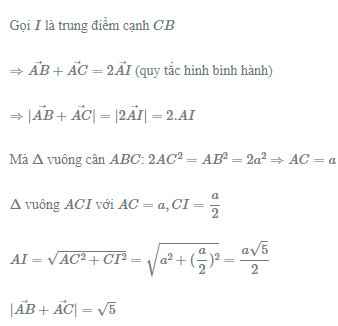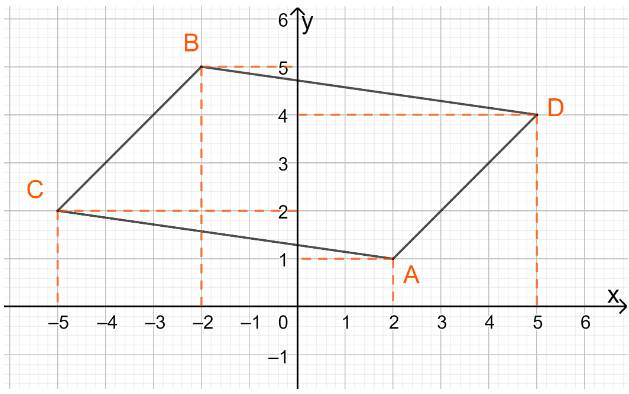Cho tam giác $A B C$ vuông tại $A$ có $A B C=30^{\circ}$ và $B C=a \sqrt{5}$.
Tính độ dài của các vectơ $\overrightarrow{A B}+\overrightarrow{B C}, \overrightarrow{A C}-\overrightarrow{B C}$ và $\overrightarrow{A B}+\overrightarrow{A C}$.
Hãy nhập câu hỏi của bạn vào đây, nếu là tài khoản VIP, bạn sẽ được ưu tiên trả lời.



a) Ta có: \(\overrightarrow {BA} = (2 - ( - 2);1 - 5) = (4; - 4)\) và \(\overrightarrow {BC} = ( - 5 - ( - 2);2 - 5) = ( - 3; - 3)\)
b)
Ta có: \(\overrightarrow {BA} .\overrightarrow {BC} = 4.( - 3) + ( - 4).( - 3) = 0\)
\( \Rightarrow \overrightarrow {BA} \bot \overrightarrow {BC} \) hay \(\widehat {ABC} = {90^o}\)
Vậy tam giác ABC vuông tại B.
Lại có: \(AB = \left| {\overrightarrow {BA} } \right| = \sqrt {{4^2} + {{( - 4)}^2}} = 4\sqrt 2 \); \(BC = \left| {\overrightarrow {BC} } \right| = \sqrt {{3^2} + {{( - 3)}^2}} = 3\sqrt 2 \)
Và \(AC = \sqrt {A{B^2} + B{C^2}} = 5\sqrt 2 \) (do \(\Delta ABC\)vuông tại B).
Diện tích tam giác ABC là: \({S_{ABC}} = \frac{1}{2}.AB.BC = \frac{1}{2}.4\sqrt 2 .3\sqrt 2 = 12\)
Chu vi tam giác ABC là: \(AB + BC + AC = 4\sqrt 2 + 3\sqrt 2 + 5\sqrt 2 = 12\sqrt 2 \)
c) Tọa độ của trọng tâm G là \(\left( {\frac{{2 + ( - 2) + ( - 5)}}{3};\frac{{1 + 5 + 2}}{3}} \right) = \left( {\frac{{ - 5}}{3};\frac{8}{3}} \right)\)
d) Giả sử điểm D thỏa mãn BCAD là một hình bình hành có tọa độ là (a; b).

Ta có: \(\overrightarrow {CB} = ( 3; 3)\) và \(\overrightarrow {AD} = (a - 2;b - 1)\)
Vì BCAD là một hình bình hành nên \(\overrightarrow {AD} = \overrightarrow {CB} \)
\(\begin{array}{l} \Leftrightarrow (a - 2;b - 1) = ( 3;3)\\ \Leftrightarrow \left\{ \begin{array}{l}a - 2 = 3\\b - 1 = 3\end{array} \right. \Leftrightarrow \left\{ \begin{array}{l}a = 5 \\b = 4\end{array} \right.\end{array}\)
Vậy D có tọa độ (5; 4)

a) \(\cos \left( {\overrightarrow a ,\overrightarrow b } \right) = \frac{{\overrightarrow a .\overrightarrow b }}{{\left| {\overrightarrow a } \right|.\left| {\overrightarrow b } \right|}} = \frac{{2.6 + ( - 3).4}}{{\sqrt {{2^2} + {{\left( { - 3} \right)}^2}} .\sqrt {{6^2} + {4^2}} }} = 0 \Rightarrow \overrightarrow a \bot \overrightarrow b \)
b) \(\cos \left( {\overrightarrow a ,\overrightarrow b } \right) = \frac{{\overrightarrow a .\overrightarrow b }}{{\left| {\overrightarrow a } \right|.\left| {\overrightarrow b } \right|}} = \frac{{3.5 + 2.( - 1)}}{{\sqrt {{3^2} + {2^2}} .\sqrt {{5^2} + {{\left( { - 1} \right)}^2}} }} = \frac{{\sqrt 2 }}{2} \Rightarrow \left( {\overrightarrow a ,\overrightarrow b } \right) = 45^\circ \)
c) \(\cos \left( {\overrightarrow a ,\overrightarrow b } \right) = \frac{{\overrightarrow a .\overrightarrow b }}{{\left| {\overrightarrow a } \right|.\left| {\overrightarrow b } \right|}} = \frac{{\left( { - 2} \right).3 + ( - 2\sqrt 3 ).\sqrt 3 }}{{\sqrt {{{\left( { - 2} \right)}^2} + {{\left( { - 2\sqrt 3 } \right)}^2}} .\sqrt {{3^2} + {{\sqrt 3 }^2}} }} = - \frac{{\sqrt 3 }}{2} \Rightarrow \left( {\overrightarrow a ,\overrightarrow b } \right) = 150^\circ \)

a) \(\overrightarrow{u}=3\overrightarrow{a}+2\overrightarrow{b}-4\overrightarrow{c}=3\left(2;1\right)+2\left(3;-4\right)-4\left(-7;2\right)\)
\(=\left(6;3\right)+\left(6;-8\right)-\left(-28;8\right)\)
\(=\left(6+6+28;3-8-8\right)=\left(40;-13\right)\).
b) \(\overrightarrow{x}+\overrightarrow{a}=\overrightarrow{b}-\overrightarrow{c}\Leftrightarrow\overrightarrow{x}=\overrightarrow{b}-\overrightarrow{c}-\overrightarrow{a}\)
\(\Leftrightarrow\overrightarrow{x}=\left(3;-4\right)-\left(-7;2\right)-\left(2;1\right)\)
\(\Leftrightarrow\overrightarrow{x}=\left(3+7-2;-4-2-1\right)\)
\(\Leftrightarrow\overrightarrow{x}=\left(8;-7\right)\).
c) Có \(\overrightarrow{c}\left(-7;2\right)=k\overrightarrow{a}+h\overrightarrow{b}=k\left(2;1\right)+h\left(3;-4\right)\)
\(=\left(2k+3h;k-4h\right)\).
Từ đó suy ra: \(\left\{{}\begin{matrix}2k+3h=-7\\k-4h=2\end{matrix}\right.\)\(\Leftrightarrow\left\{{}\begin{matrix}k=-2\\h=-1\end{matrix}\right.\).

a) Ta có: \(\overrightarrow {AB} = (3 - 1;4 - 2) = (2;2)\) và \(\overrightarrow {CD} = (6 - ( - 1);5 - ( - 2)) = (7;7)\)
b) Dễ thấy: \((2;2) = \frac{2}{7}.(7;7)\)\( \Rightarrow \overrightarrow {AB} = \frac{2}{7}.\overrightarrow {CD} \)
Vậy hai vectơ \(\overrightarrow {AB} \) và \(\overrightarrow {CD} \) cùng phương.
c) Ta có: \(\overrightarrow {AC} = ( - 1 - 1; - 2 - 2) = ( - 2; - 4)\) và \(\overrightarrow {BE} = (a - 3;1 - 4) = (a - 3; - 3)\)
Để \(\overrightarrow {AC} \) và \(\overrightarrow {BE} \) cùng phương thì \(\frac{{a - 3}}{{ - 2}} = \frac{{ - 3}}{{ - 4}}\)\( \Leftrightarrow a - 3 = - \frac{3}{2}\)\( \Leftrightarrow a = \frac{3}{2}\)
Vậy \(a = \frac{3}{2}\) hay \(E\left( {\frac{3}{2};1} \right)\) thì hai vectơ \(\overrightarrow {AC} \) và \(\overrightarrow {BE} \) cùng phương
d)
Cách 1:
Ta có: \(\overrightarrow {BE} = \left( {\frac{3}{2} - 3; - 3} \right) = \left( { - \frac{3}{2}; - 3} \right)\) ; \(\overrightarrow {AC} = ( - 2; - 4)\)
\( \Rightarrow \overrightarrow {BE} = \frac{3}{4}.\overrightarrow {AC} \)
Mà \(\overrightarrow {AE} = \overrightarrow {AB} + \overrightarrow {BE} \) (quy tắc cộng)
\( \Rightarrow \overrightarrow {AE} = \overrightarrow {AB} + \frac{3}{4}.\overrightarrow {AC} \)
Cách 2:
Giả sử \(\overrightarrow {AE} = m\,.\,\overrightarrow {AB} + n\,.\,\overrightarrow {AC} \)(*)
Ta có: \(\overrightarrow {AE} = \left( {\frac{1}{2}; - 1} \right)\), \(m\,.\,\overrightarrow {AB} = m\left( {2;2} \right) = (2m;2m)\), \(n\,.\,\overrightarrow {AC} = n( - 2; - 4) = ( - 2n; - 4n)\)
Do đó (*) \( \Leftrightarrow \left( {\frac{1}{2}; - 1} \right) = (2m;2m) + ( - 2n; - 4n)\)
\(\begin{array}{l} \Leftrightarrow \left( {\frac{1}{2}; - 1} \right) = (2m - 2n;2m - 4n)\\ \Leftrightarrow \left\{ \begin{array}{l}\frac{1}{2} = 2m - 2n\\ - 1 = 2m - 4n\end{array} \right. \Leftrightarrow \left\{ \begin{array}{l}m = 1\\n = \frac{3}{4}\end{array} \right.\end{array}\)
Vậy \(\overrightarrow {AE} = \overrightarrow {AB} + \frac{3}{4}.\overrightarrow {AC} \)